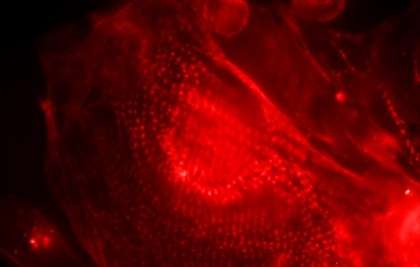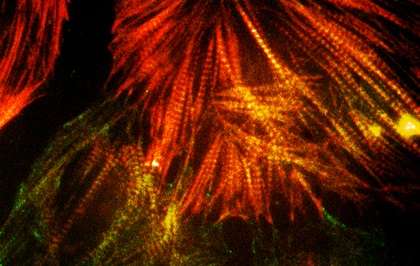Scientists grow tiny beating human hearts to give them heart disease and find a cure

(Medical Xpress)—Miniature human hearts that beat of their own accord are being grown by scientists at Abertay University.
They have been developed specifically to find a cure for heart hypertrophy - a form of heart disease that can lead to sudden death.
Made from stem cells, the tiny hearts are just 1mm in diameter and contract at around 30 beats per minute.
Although healthy to begin with, the scientists are using chemicals to simulate the physiological conditions that will make them become hypertrophic - enlarged, due to abnormal growth of the cells that make up the heart (cardiomyocytes).
Once diseased, the hearts are then treated with newly developed medications to see if they can prevent the damage from occurring.
Professor Nikolai Zhelev, who is leading this research, explains:
"Although human hearts have been grown in labs before, this is the first time it has ever been possible to induce disease in them.
"Heart hypertrophy can be hereditary, can be caused by diseases such as diabetes, or can be caused by doing too much strenuous exercise.
"The disease causes the heart muscle to thicken and stiffen, and makes it harder for the heart to pump blood around the body.
"In some people, a life-threatening abnormal heart rhythm will develop, and this is the most common cause of sudden death in young people.
"Although there are treatments, these only help to control the symptoms, and there is no known cure at the moment."
However, the miniature hearts being grown in Professor Zhelev's lab could help change that.
Using biosensors, Professor Zhelev has been able to label specific molecules within the miniature hearts to see where they are going - which pathway they follow.
By establishing which molecules cause the hearts to become hypertrophic, he has been able to target drugs at these molecules and prevent them from going down the path they would usually take, and prevent them from becoming hypertrophic.
He continues: "We've tested a number of different compounds on these hearts - some of them entirely new ones that haven't been tested in humans yet, which is why we're testing them on these hearts we've grown in the lab.
"One of these compounds, however, is a drug that we have developed which has just completed phase-two clinical trials in cancer patients and has had very positive results.
"Although heart cells are the only ones in the body that will never get cancer, we noticed that the pathways the molecules in hypertrophic hearts follow are similar to those followed by molecules in cancerous cells, so we thought testing this new drug on these hearts might have the same positive effect. And this has certainly proved to be the case.
"Some of the compounds we've tested have had undesirable effects - such as increasing the number of beats the hearts do per minute and making them stop beating - but others, such as the new cancer drug that is in development, have managed to protect the hearts and prevent them from becoming hypertrophic.

"We are still testing new drugs using this system to find new compounds with better efficiency and fewer side-effects.
"Once we know exactly which compounds work and which don't we'll begin developing new drugs which will then undergo further tests, before eventually being trialled in humans.
"Although there is still a long way to go before the drugs become available commercially, we are extremely hopeful that we will one day be able to stop heart hypertrophy from developing in those at risk of the disease."
To move the experiments further along, Professor Zhelev has begun working with Professor Jim Bown - a systems biologist who uses computer models and games technology to visualise cell behaviour.
He has started taking the data from Professor Zhelev's experiments to create computer models that will predict how the cells are likely to grow.
This means that, rather than merely looking at a set of mathematical equations, Professor Zhelev will be able to see how the cells he is growing are likely to develop over time and how they will be affected by a particular drug.
Working with partners at St Andrews and Edinburgh universities, Professor Bown has already shown that this technology can inform experiments in cancer.
This research with heart hypertrophy is an exciting new development and the model could, eventually, be used to help find cures and preventative treatments for other types of diseases as well.
Professor Bown explains:
"By creating interactive models and interactive animations which visualise cell growth, we are able to simulate what would happen if different doses and combinations of drugs are applied to cancerous cells, and to predict how they will affect cell growth.
"Because the signalling pathways in cancer cells and hypertrophic heart cells are so similar, we've been able to adapt this technology and apply it to cardiomyocytes.
"The way this will work is by taking information about how the cells grow from Nikolai initially, building models based on that data and making suggestions to him about which experiments to try out next. So we're carrying out a mix of experimental and theoretical biology here, using complex new technology to help us better understand the systems we're working with.
"Ultimately, the aim is to reduce the number of wet-lab experiments that Nikolai needs to do in order to find the drugs that are most likely to prevent heart hypertrophy from developing."




















